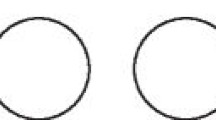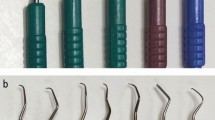Abstract
Data sources Data sources were Medline, the Cochrane Controlled Trials Register, Biosis, EMBASE, Health Devices Alerts, Meditec, Russmed articles and Scisearch dated up to April 2001, and reference lists from relevant articles.
Study selection Randomised controlled trials were selected if they had at least 6 months’ follow-up and compared machine-driven instruments with hand instruments for the treatment of chronic periodontitis.
Data extraction and synthesis Information regarding the quality and characteristics of studies was extracted independently by two reviewers. Kappa scores determined their agreement. Prevention of tooth loss was the primary outcome, with secondary outcomes of prevention of disease progression, resolution of anatomical defects and resolution of gingival inflammation also considered. Efficiency was assessed as the mean time needed to treat one tooth. Qualitative synthesis was conducted for all outcomes except time needed to treat one tooth, where a meta-analysis was performed.
Results Thirteen studies were included in the review. No study reported on the selected primary outcome variables. Using the outcome variables of clinical attachment gain, probing pocket-depth reduction or bleeding on probing-reduction, there appeared to be no differences between ultrasonic/sonic and manual debridement. No major differences in the frequency or severity of adverse effects were found. Ultrasonic/sonic debridement was found to take significantly less time, ie, 36.6% of the time for debridement using hand instruments.
Conclusions Ultrasonic/sonic subgingival debridement requires less time than use of hand instruments. The data did not indicate a difference between ultrasonic/sonic and manual debridement for the treatment of chronic periodontitis for single-rooted teeth but the evidence is not very strong. High quality trials are needed to assess the efficacy of machine-driven subgingival debridement. Clinical outcome variables that have a tangible benefit to the patients should be used.
Similar content being viewed by others
Log in or create a free account to read this content
Gain free access to this article, as well as selected content from this journal and more on nature.com
or
References
Cobb CM . Non-surgical pocket therapy: mechanical. Ann Periodontol 1996; 1:443–490.
Leon LE, Vogel RI . A comparison of the effectiveness of hand scaling and ultrasonic debridement in furcations as evaluated by differential dark-field microscopy. J Periodontol 1987; 58:86–94.
Oda S, Ishikawa I . In vitro effectiveness of a newly-designed ultrasonic scaler tip for furcation areas. J Periodontol 1989; 60:634–639.
Author information
Authors and Affiliations
Additional information
Address for correspondence: Thomas F Flemmig, Department of Periodontology, University Clinic Münster, Waldeyerstrasse 30, 48149 Münster, Germany. E-mail: flemmig@uni-muenster.de
Tunkel J, Heinecke A, Flemmig TF. A systematic review of efficacy of machine-driven and manual subgingival debridement in the treatment of chronic periodontitis. J Clin Periodontol 2002; 29(Suppl. 3):S72–S81
Rights and permissions
About this article
Cite this article
Teles, R. No difference between ultrasonic/sonic and manual debridement for the treatment of chronic periodontitis?. Evid Based Dent 4, 56 (2003). https://doi.org/10.1038/sj.ebd.6400212
Published:
Issue date:
DOI: https://doi.org/10.1038/sj.ebd.6400212



